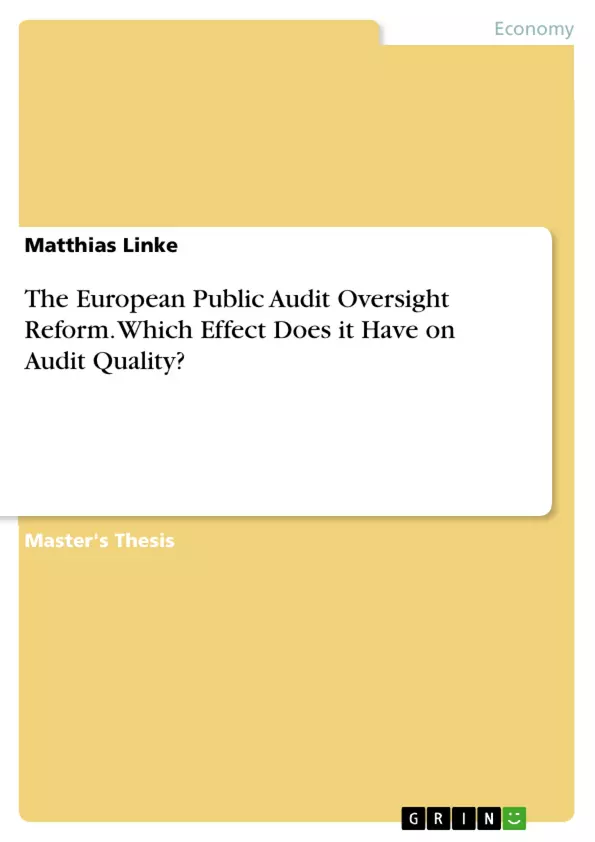This paper examines the effect of the European public audit oversight reform on audit quality. Accounting scandals at the beginning of the 21th century called the audit profession into question and raised serious concerns on the oversight system in place. In an attempt to regain investors’ confidence, the European Commission (hereafter referred to as EC) followed the American example and passed Directive 2006/43/EC, which requires the Member States of the European Union (hereafter referred to as EU) to set up public oversight systems for statutory auditors and audit firms.
The paper provides empirical evidence that managers are less likely to commit earnings management in the years following the regulatory reform compared to the years preceding the reform, indicating higher audit quality in the post-reform period. Member States of the EU can choose between two options for national public oversight of auditors; the full-time inspection model and the model which consists of peer reviews with an independent commission monitoring this process. I run several analyses with different models and test whether firms in jurisdictions that implemented the full-time inspection model exhibit lower discretionary accruals compared to firms in jurisdictions that implemented the modified peer review model. The results are contradicting and do not support a conclusion.
Inhaltsverzeichnis (Table of Contents)
- INTRODUCTION.
- BACKGROUND………......
- THE PIONEER – PUBLIC AUDIT OVERSIGHT IN THE U.S…
- THE FOLLOWER – PUBLIC AUDIT OVERSIGHT IN THE EU.
- THE VOLUNTEERS – PUBLIC AUDIT OVERSIGHT AT AN INTERNATIONAL LEVEL
- THE INTENTION – ENHANCEMENT OF AUDIT QUALITY.
- AUDIT QUALITY.
- LINKING PUBLIC AUDIT OVERSIGHT TO AUDIT QUALITY
- LITERATURE REVIEW AND DEVELOPMENT OF HYPOTHESES...
- RESEARCH ON SELF-REGULATED PEER REVIEWS.
- RESEARCH ON INDEPENDENT INSPECTIONS..
- DATA AND RESEARCH METHOD
- SAMPLE AND DESCRIPTIVE STATISTICS.
- EMPIRICAL MODEL.
- THE MODIFIED JONES MODEL
- ABNORMAL WORKING CAPITAL ACCRUALS
- DEPENDENT VARIABLE .......
- INDEPENDENT VARIABLES..
- CONTROL VARIABLES..
- EMPIRICAL RESULTS..
- SENSITIVITY TEST.
- ROBUSTNESS TEST.
- CONCLUSION ..
Zielsetzung und Themenschwerpunkte (Objectives and Key Themes)
This paper investigates the effect of the European public audit oversight reform on audit quality, specifically focusing on the impact of the reform on earnings management practices. It aims to determine whether Directive 2006/43/EC has led to increased audit quality, measured through the level of abnormal accruals. Additionally, the paper examines the effectiveness of the two main public oversight models employed in the EU: full-time inspection and peer review with an independent commission monitoring. It explores whether one model is superior in reducing discretionary accruals and subsequently, enhancing audit quality.
- Impact of the European public audit oversight reform on audit quality
- Measurement of audit quality through earnings management
- Comparison of the effectiveness of full-time inspection and peer review oversight models
- Analysis of discretionary accruals in relation to public oversight models
- Evaluation of the regulatory environment and its impact on financial reporting practices
Zusammenfassung der Kapitel (Chapter Summaries)
- INTRODUCTION: This chapter introduces the research topic, highlighting the significance of public audit oversight reforms in light of accounting scandals at the beginning of the 21st century. It provides an overview of the regulatory environment, particularly focusing on the Sarbanes-Oxley Act of 2002 in the U.S. and the subsequent European Union Directive 2006/43/EC. The chapter outlines the research questions and objectives of the study.
- LITERATURE REVIEW AND DEVELOPMENT OF HYPOTHESES: This chapter reviews existing literature on the effectiveness of self-regulated peer reviews and independent inspections in enhancing audit quality. It explores previous research on the impact of public oversight on earnings management and develops hypotheses to be tested in the empirical analysis.
- DATA AND RESEARCH METHOD: This chapter describes the data used in the study, including the sample selection criteria and descriptive statistics. It outlines the empirical model used to analyze the relationship between public audit oversight and audit quality, particularly focusing on the modified Jones model and the measurement of abnormal working capital accruals.
- EMPIRICAL RESULTS: This chapter presents the empirical findings of the study, examining the impact of Directive 2006/43/EC on earnings management and the effectiveness of the two public oversight models. It provides detailed analysis of the data and discusses the statistical significance of the results.
Schlüsselwörter (Keywords)
The key terms and concepts explored in this paper include: quality of accruals, earnings quality, audit quality, public audit oversight, earnings management, discretionary accruals, full-time inspection, peer review, and regulatory environment.
- Citar trabajo
- Matthias Linke (Autor), 2015, The European Public Audit Oversight Reform. Which Effect Does it Have on Audit Quality?, Múnich, GRIN Verlag, https://www.grin.com/document/495142



